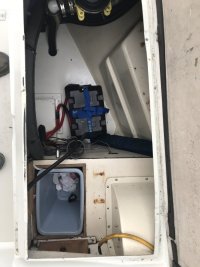frosero7744
Member II
Hey guys. i got to spend some quality time with my Yanmar replacing the mixing elbow with some quality help. One thing that was noticed were some rust spots on the engine. Yanmars have an oil line in back that can get brittle if it gets rusty so thats my concern besides the surface rust. It appears the PSS Shaft vent line run above the engine and it appears occasionally sends a bit of water spitting out. Its the grey line about 11oclock with a brass fitting which has greened up a bit. My help told me i should move to the starboard lazerette so any water spits out there instead. I called PSS and talked to their quite helpful staff who recommended leaving in the engine compartment since it the closest to centerline, but also add an accessory they have called Hy-vent. This device says it blocks water but allows air to move about.
Has anyone tried this? thoughts about keeping the vent line in the engine compartment? My plan is to cut back the vent line a few inches to allow for the Hy-vent device to go in the top left side looking at the engine. Thoughts or comments while i wait for another boat day?

Hy Vent
https://store.pyiinc.com/products/hy-vent
Has anyone tried this? thoughts about keeping the vent line in the engine compartment? My plan is to cut back the vent line a few inches to allow for the Hy-vent device to go in the top left side looking at the engine. Thoughts or comments while i wait for another boat day?

Hy Vent
https://store.pyiinc.com/products/hy-vent

